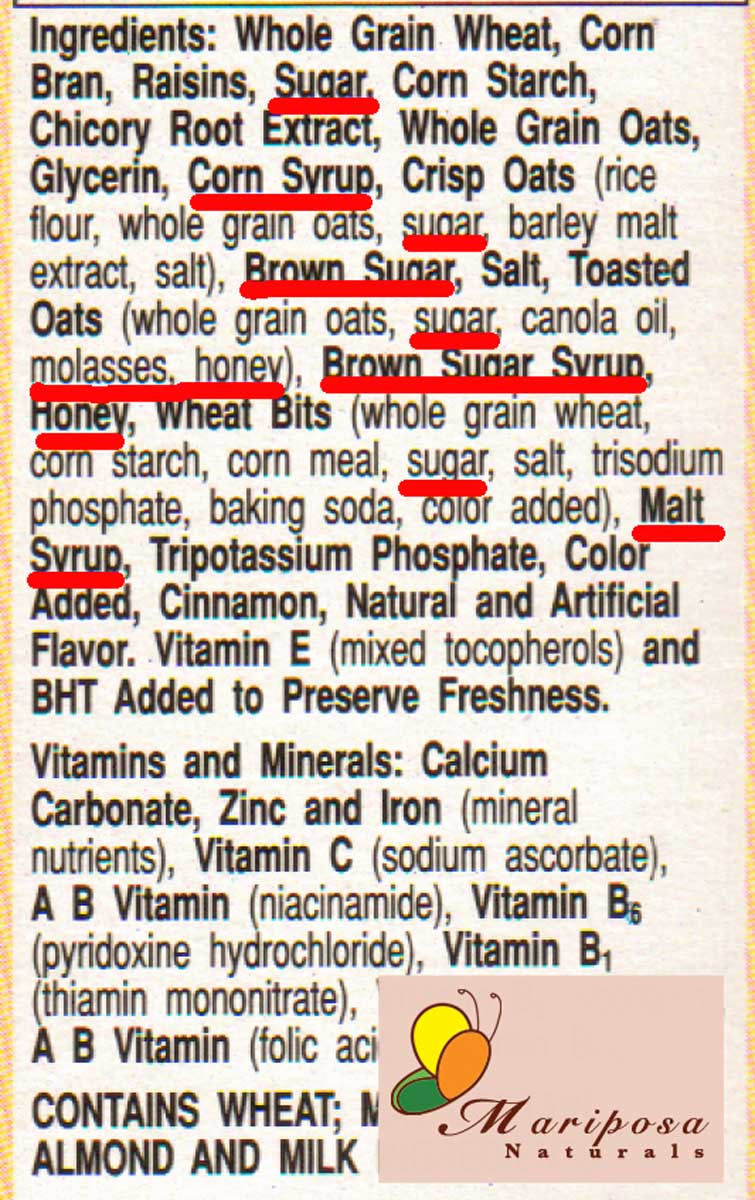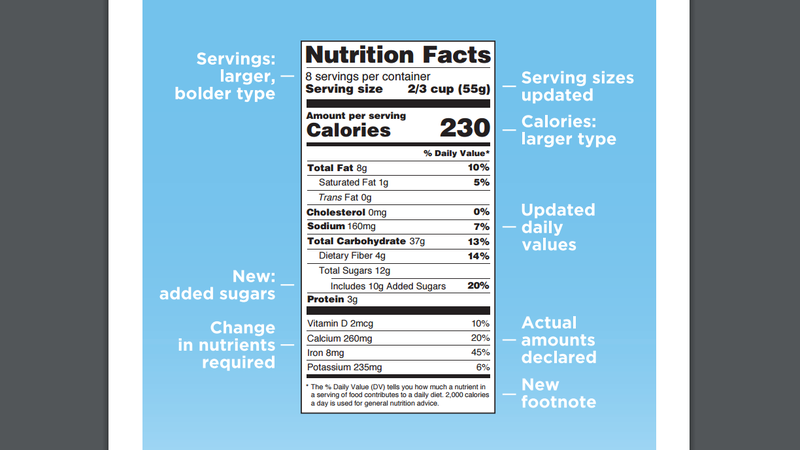39 reading nutrition labels sugar
Fats, sugar, carbs: Here's how to read food labels for healthy and ... Understanding nutrition labels on food packaging can help you make better food choices and manage your intake of energy, sugar, fats, proteins, fibre, salt, minerals, and vitamins. Sneaky Sugars: How to read food labels - Natvia - 100% Natural Sweetener The tricky part comes when you realise that this counts ALL sugars - added sugars as well as those that naturally occur in food, such as fruit. This means that a product that claims to be 'no added sugars' can still be high in its overall sugar content. Sneaky! Dietary fibre: You won't see this on all food labels. It only needs to be ...
PDF Read the Nutrition Facts Label for Sugar! - NHLBI, NIH The nutrient amounts provided on the label are for one serving. If you have more than one serving, you will get more calories and other nutrients. For example, if you drink two servings (2 cups) of mango nectar, you will take in 460 calories and 100 grams of sugar. Calories and Sugar Here are the amounts of calories and sugar in one serving.

Reading nutrition labels sugar
How To Read Food labels for Sugar | My Sugar Free Kitchen On the label check the sugars in the nutrition panel. 5g/ml or less of sugar per 100g/ml = this would count as low sugar content. It means 5% of the ingredients are sugar Between 5g/ml and 20g/ml of sugar per 100 grams = medium sugar content. With 20ml of sugar per 100 ml, this means the product is 20% sugar…not so good. How to Read Nutrition Labels for Sugar - hekagoodfoods Keep in mind, one gram of sugar is roughly equivalent to 1/4 teaspoon of sugar. A percentage indicating how much of your recommended daily intake the item contains. While this is helpful to reference, the FDA recommends natural and added sugars account for no more than 10% of your daily caloric intake. What to Look for in the Ingredients List Sugars on food labels - Sugar Nutrition Resource Centre The sugars in the ingredients list are only those which have been added to the product. The sugars in the nutrition information panel refers to total sugars - this includes sugars added as an ingredient but also those which are naturally present in the food. FURTHER READING. FSANZ Food Labels - what do they mean. Acessed 29.07.2020
Reading nutrition labels sugar. How To Read Nutrition Labels - Holistic Health Path The Recommended Daily Allowance is 2300 milligrams for a normal healthy adult, and if you have high blood pressure it goes down to 1500 milligrams. Please remember that when you see any amount of fat or sodium or anything else on a label, that number is PER SERVING - so check the serving size or number of servings in case you eat the whole package! How to read labels for added sugar - That Sugar Movement Three: Remember that 4g = 1 teaspoon of sugar Technically, 4.2g = 1 teaspoon of sugar, but for the easy on-the-spot calculation, just remember 4g equals one teaspoon. For example, a 375ml can of Coca-Cola is about 40g of sugar. Dividing that by 4 means there are 10 teaspoons of added sugar in the one can. FDA Nutrition Label Update: How to Read the New Food Label | U.S. News How to Read the New Food Labels After the FDA Nutrition Label Revision. ... or six teaspoons of added sugar for women each day and 150 calories or nine teaspoons for men. Consider that a single ... How to Read Food Labels Without Being Tricked - Healthline The product may contain very little whole grains. Check the ingredients list — if whole grains aren't in the first three ingredients, the amount is negligible. Fortified or enriched. This ...
Reading Food Labels When You Have Diabetes - WebMD It has measurements of fat, cholesterol, sodium, carbohydrates, protein, vitamins, and minerals for a typical amount of that food. This information can make it easier for you to choose foods that... Learning To Read Labels :: Diabetes Education Online On a nutrition food label, subtract the fiber from the total carbohydrate amount. When you read food labels, the grams of sugar are already included in the total carbohydrate amount, so you do not need to count this sugar amount separately. The grams of sugar listed include both natural sugars, from fruit or milk, and added sugars. How to Read a Label - Natural Sugar versus Added Sugar You can tell them apart by reading the list of INGREDIENTS on the label just under the Nutrition Facts box. Locate the *Ingredients* list on the food label. Trick is to differentiate between ingredients that add sugar (high fructose corn syrup or sucrose) and ingredients that have natural sugar that is inherent in the raw or base food. How To Read Food and Beverage Labels - National Institute on Aging Most older adults exceed the recommended limits for saturated fats, sodium, and added sugars. Compare and choose foods to get less than 100% DV of these each day, making sure to adjust for how many calories are in your diet. Additionally, many older adults do not get the recommended amounts of dietary fiber, vitamin D, calcium, and potassium.
Making Sense of Regenerative Labels - FoodPrint 5 Tips from an Expert on How to Read Food Labels. December 22, 2020. On Restaurant Menus, Environmental Metrics are the New Calorie Counts. November 30, 2020. How Sustainable Are Sugar Substitutes? September 24, 2020. Food Labels That Protect The Birds and the Bees (and the Fish) March 3, 2020. Understanding sugar content on food labels - Diabetes Care Community Understanding sugar content on food labels is important, to ensure that you're consuming healthy amounts. Reading the ingredient lists and nutrition facts tables on packaged foods is a helpful way for you to check what kind, and how much, sugar a product has. Finding sugar content in the ingredients list Reading food labels: Tips if you have diabetes - Mayo Clinic Look for foods with 3 or more grams of fiber. Put sugar-free products in their place Sugar-free doesn't mean carbohydrate-free. Sugar-free foods may play a role in your diabetes diet, but remember that it's equally important to consider carbohydrates as well. A sugar-free label means that one serving has less than 0.5 grams of sugar. How to Read Nutrition Labels When You Have Diabetes The right meal plan is essential if you want stable blood sugar levels. Knowing your way around food labels is a good way to stay on track. ... How to Read a Nutrition Label for Diabetes .

UNDERSTANDING FOOD LABELS - MAKE THE BEST FOOD DECISIONS | Nutrition labels, Nutrition, Reading ...
Reading Food Labels | ADA - American Diabetes Association Put food labels to work. The Nutrition Facts labels on foods are really the key to making the best choices. We'll cover the basics so that these labels make shopping easier for you. You've heard it all. From carb-free to low-carb, to whole and empty carbs, it's hard to know what it all means. Blood sugar highs and lows aren't always ...
Sugar and Food Labels: What to Look For - PartnerMD The best thing to do when you're looking at food labels is to look for anything that ends in -ose. Carbohydrates actually are sugars, but they come in different forms: complex and simple. What we're talking about here are simple sugars, like table sugar, cane syrup, and molasses. I'm going to read off several of these because it is a very long ...
Food Labels | CDC All the numbers on this label are for a 2/3-cup serving. This package has 8 servings. If you eat the whole thing, you are eating 8 times the amount of calories, carbs, fat, etc., shown on the label. Total Carbohydrate shows you types of carbs in the food, including sugar and fiber. Choose foods with more fiber, vitamins, and minerals.
Decoding Diabetes: How to Read Nutrition Labels | Accu-Chek Typically, a nutrition label will have different lines for: Total Fat, with breakdowns of both Saturated Fat and Trans Fat Cholesterol Sodium Total Carbohydrates, with breakdowns of Dietary Fiber, Sugar, and Sugar Alcohol Protein
How to Read Nutrition Facts Labels the Right Way - GoodRx Potassium. Calcium. Iron. Vitamin D. Most Americans do not consume enough of these nutrients, but they all can play a role in protecting your body from diseases, lowering your blood sugar, and improving your cholesterol levels. It's a good idea to choose foods that contain higher amounts of these nutrients.
How to Read Labels for Added Sugar | Naturally Savvy The American Heart Association (AHA) recommends no more than 100 calories (about 6 teaspoons or 24 grams) of added sugar daily for women and no more than 150 calories (about 9 teaspoons or 36 grams) of added sugar daily for men.
Added Sugars on the New Nutrition Facts Label | FDA Let the Nutrition Facts Label Be Your Guide The new Nutrition Facts label can help you compare and choose foods that are lower in added sugars. Check the label to see if foods are LOW or HIGH in...
LABEL READING: CARBOHYDRATES AND SUGARS - Renaissance Nutrition Center The carbohydrate section is the most interesting part of the label to read. It is challenging and confusing for those of us trying to follow a "sugar free" or "no added sugar" food plan. ... On food labels, "sugar" also refers to sugar-based sweetening agents, such as high-fructose corn syrup and sucrose. These very sweet sugars are ...
How to Understand and Use the Nutrition Facts Label | FDA Added Sugars on the Nutrition Facts label include sugars that are added during the processing of foods (such as sucrose or dextrose), foods packaged as sweeteners (such as table sugar), sugars from...
Understanding Food Nutrition Labels | American Heart Association Remember that the information shown in the label is based on a diet of 2,000 calories a day. You may need less or more than 2,000 calories depending upon your age, gender, activity level, and whether you're trying to lose, gain or maintain your weight. When the Nutrition Facts label says a food contains "0 g" of trans fat, but includes ...
Sugars on food labels - Sugar Nutrition Resource Centre The sugars in the ingredients list are only those which have been added to the product. The sugars in the nutrition information panel refers to total sugars - this includes sugars added as an ingredient but also those which are naturally present in the food. FURTHER READING. FSANZ Food Labels - what do they mean. Acessed 29.07.2020
How to Read Nutrition Labels for Sugar - hekagoodfoods Keep in mind, one gram of sugar is roughly equivalent to 1/4 teaspoon of sugar. A percentage indicating how much of your recommended daily intake the item contains. While this is helpful to reference, the FDA recommends natural and added sugars account for no more than 10% of your daily caloric intake. What to Look for in the Ingredients List
How To Read Food labels for Sugar | My Sugar Free Kitchen On the label check the sugars in the nutrition panel. 5g/ml or less of sugar per 100g/ml = this would count as low sugar content. It means 5% of the ingredients are sugar Between 5g/ml and 20g/ml of sugar per 100 grams = medium sugar content. With 20ml of sugar per 100 ml, this means the product is 20% sugar…not so good.












Post a Comment for "39 reading nutrition labels sugar"